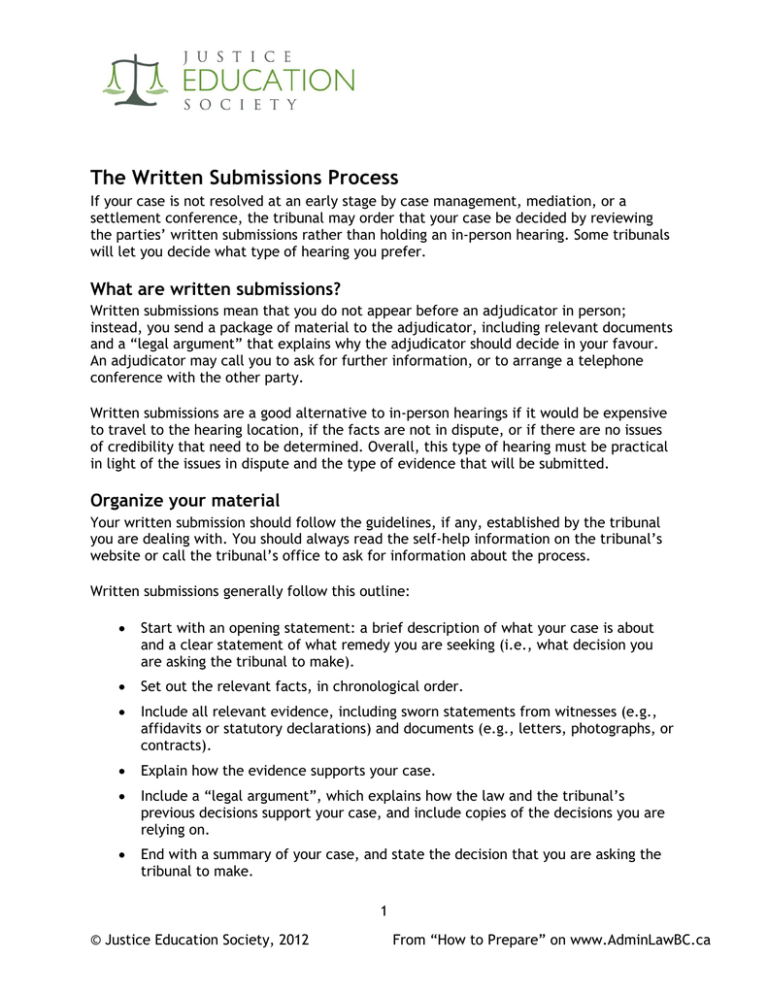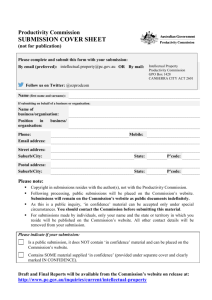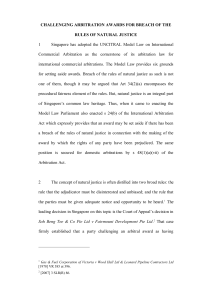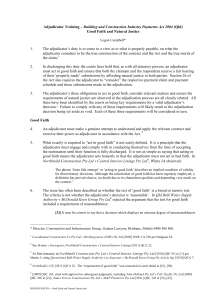The Written Submissions Process
advertisement

The Written Submissions Process If your case is not resolved at an early stage by case management, mediation, or a settlement conference, the tribunal may order that your case be decided by reviewing the parties’ written submissions rather than holding an in-person hearing. Some tribunals will let you decide what type of hearing you prefer. What are written submissions? Written submissions mean that you do not appear before an adjudicator in person; instead, you send a package of material to the adjudicator, including relevant documents and a “legal argument” that explains why the adjudicator should decide in your favour. An adjudicator may call you to ask for further information, or to arrange a telephone conference with the other party. Written submissions are a good alternative to in-person hearings if it would be expensive to travel to the hearing location, if the facts are not in dispute, or if there are no issues of credibility that need to be determined. Overall, this type of hearing must be practical in light of the issues in dispute and the type of evidence that will be submitted. Organize your material Your written submission should follow the guidelines, if any, established by the tribunal you are dealing with. You should always read the self-help information on the tribunal’s website or call the tribunal’s office to ask for information about the process. Written submissions generally follow this outline: Start with an opening statement: a brief description of what your case is about and a clear statement of what remedy you are seeking (i.e., what decision you are asking the tribunal to make). Set out the relevant facts, in chronological order. Include all relevant evidence, including sworn statements from witnesses (e.g., affidavits or statutory declarations) and documents (e.g., letters, photographs, or contracts). Explain how the evidence supports your case. Include a “legal argument”, which explains how the law and the tribunal’s previous decisions support your case, and include copies of the decisions you are relying on. End with a summary of your case, and state the decision that you are asking the tribunal to make. 1 © Justice Education Society, 2012 From “How to Prepare” on www.AdminLawBC.ca Review and respond to the other submission Both parties will have an opportunity to read and respond to the other party’s submission. This is done in one of two ways: 1. “Staggered submissions” are done in sequence. First, the party who is making the complaint or appealing delivers their written statement. The other party makes their submission and replies to the first submission within a fixed time limit. Then the first party has a final opportunity to respond. It is very important to adhere to the time limits set by the tribunal. 2. In a “simultaneous submission”, both parties deliver their written submissions to the adjudicator and are given an opportunity to respond to the other party’s submission on a specified date. Review the other party’s submission to understand their position and how to rebut their arguments. When you respond to the other party’s submission, explain why their case does not tell the whole story, provide missing information, point out errors and omissions that the other party has made, and reiterate how the facts of your case support the order that you are seeking. You cannot usually introduce new evidence at this stage of the proceedings, as all relevant evidence should have been included in your first written submission. If you have forgotten to submit relevant evidence at an earlier stage, you must get the adjudicator’s consent to submit additional evidence. If the adjudicator has further questions or needs more information, he or she may set up a telephone conference with both parties or ask for further written submissions. After the tribunal’s review After the adjudicator has reached a decision in your case, the tribunal will send you the decision, with written reasons. When you deliver your written submissions, you should ask how long it will take for the adjudicator to make a decision. Due to the heavy volume of cases to review, it may be several months before you receive the decision. What if I don’t agree with the decision? If you don’t agree with the adjudicator’s decision in your case, you can sometimes have the decision reviewed. Some tribunals have their own internal review process, followed by an appeal to an independent tribunal. Other tribunals’ decisions may be appealed to the courts by a process called “judicial review”. The fact that you do not agree with the adjudicator’s decision is not a reason that entitles you to review by the court — you must show that the adjudicator’s process was flawed or that the adjudicator made an error of law, jurisdiction, or fairness. 2 © Justice Education Society, 2012 From “How to Prepare” on www.AdminLawBC.ca


